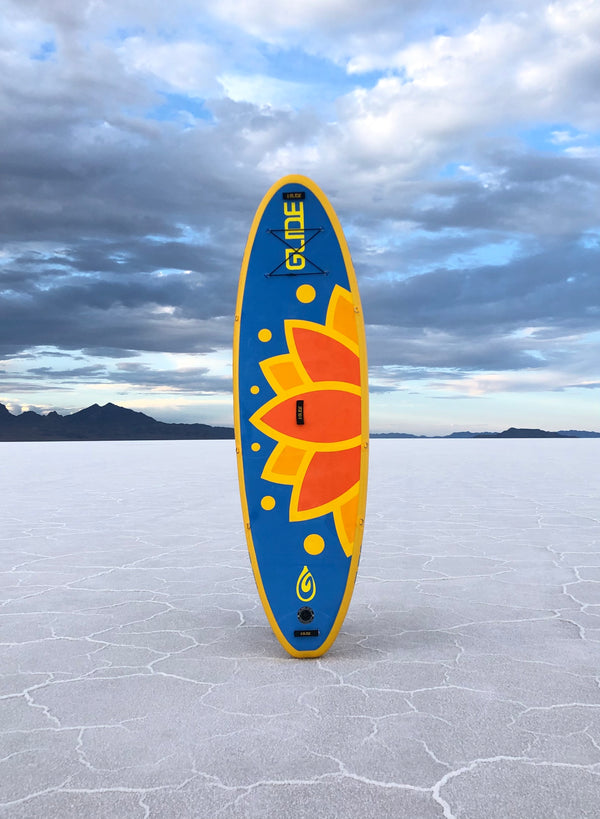
Are Glide Inflatables the Best Inflatable Paddle Board?
Most of our competitors aren't avid or even experienced paddle boarders.
Our founder Ken Driscoll who was a professional kayak turned paddler after his spine broke through an accident (read more about him here), and he is here to walk you through myths and facts of inflatable board construction and how to tell the cheap inflatables from the ones that will actually last and perform for your money.
Key Highlights
- Founder's Expertise: Ken Driscoll, a professional turned paddle board enthusiast due to an accident, founded Glide with a commitment to quality and performance.
- Construction Types Explained: Glide avoids the pitfalls of single-layer boards, enhances double-layer boards, and excels with glue-free fusion technology.
- Superior Materials: Glide SUPs use woven drop-stitch fabric for increased stiffness and durability, setting them apart from competitors using knitted versions.
- PSI as a Quality Indicator: Glide boards boast a 25 PSI rating, indicating their superior build and ability to perform under rigorous conditions.
- Market Position: Positioned as premium products, Glide SUPs offer features that are beneficial for both novices and experienced paddlers, enhancing their overall paddle boarding experience.
Why Glide Inflatable Paddle Boards Reign Supreme

Are you on the hunt for the ultimate inflatable paddle board? Look no further than Glide's range of SUP boards. Yes, you've heard it right! Our inflatable SUPs are not just good; they're the best in the market. Picture this: the moment your new paddle board arrives, you're not just receiving a piece of equipment; you're getting an entry ticket to the "cool kid club." Expect envious glances from neighbors and curious onlookers asking you about your sleek SUP board.
Still not convinced? Let's dive into why choosing a Glide inflatable SUP board is a decision you won't regret, and why our boards stand out in a sea of options that might seem appealing at a glance but don't measure up in quality.
Inflatable Paddle Board Construction: A Peek Behind the Curtain
There are three main types of inflatable SUP construction: single layer, double layer, and fusion. Anything beyond these is likely just marketing fluff. Let's break down these types so you can see why Glide boards are a cut above the rest.
Single Layer Boards: As the name suggests, these boards consist of a single layer of PVC material over drop-stitch fabric. While this makes them the most affordable, it also makes them the least durable. Prone to issues like seam failure, twisting, and delamination, single layer boards are, frankly, a poor investment. Glide, however, does not compromise on quality by using such methods.
Double Layer Boards: Building upon the single layer design, double layer boards feature an additional layer of PVC. This construction improves durability, reduces twisting, and increases stiffness, albeit at the cost of being heavier. While considered high-quality, the glue used to bond these layers can lead to delamination over time. At Glide, we believe in better.
Fusion Construction: Enter the pinnacle of inflatable SUP technology - fusion construction. This innovative method fuses two layers of material without the use of glue, resulting in a board that's not only stronger and stiffer but also lighter than double layer boards. This is the secret behind the unmatched performance of Glide inflatable paddle boards.
The Magic of Drop Stitch Fabrics

Delving deeper into what makes an SUP exceptional, we encounter the core material - drop stitch fabric. Available in knitted and woven variants, this fabric is what allows inflatable boards to maintain their shape under high pressure. While most boards use the more common knitted drop stitch, Glide SUP boards are crafted with premium woven drop stitch fabric. This choice is pivotal, as woven fabric significantly enhances the stiffness and durability of our boards without the need for high PSI.
Making the Right Choice
Amid a myriad of inflated claims and jargon like "military grade" or "ultra-durable," it's easy to get lost. A simple rule of thumb is to look at the board's maximum PSI rating. Here's a quick guide:
- 1-12 PSI indicates a single layer board.
- 12-20 PSI suggests a double layer board.
- 20+ PSI signals a fusion board - the realm where Glide inflatable paddle boards excel, boasting a 25PSI max.
Conclusion
In a market flooded with choices, knowing the ins and outs of inflatable paddle board construction and materials is key to making an informed purchase. Glide stands out not just for the superior construction and materials we use but for our commitment to delivering a paddle boarding experience that's second to none. Whether you're a seasoned pro or a beginner eager to hit the water, a Glide inflatable paddle board is your ticket to unmatched performance, durability, and enjoyment.
Welcome to the Glide family, where excellence meets the open water.
Related Topics
Things to Consider When Buying a SUP
Improving Fitness on Paddle Board
How Inflatable Paddle Board Technology Changed The SUP Industry


